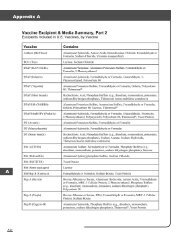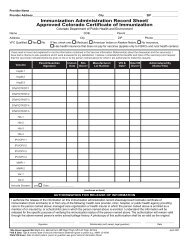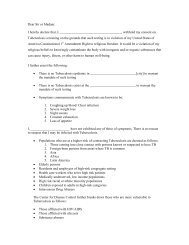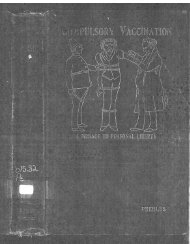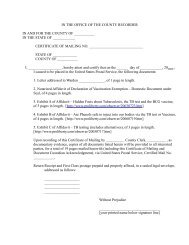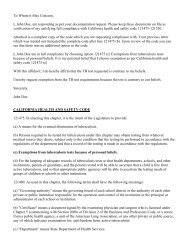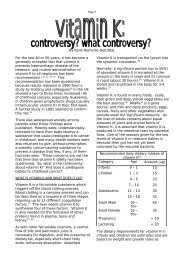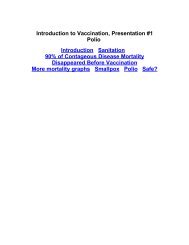Vitamin K Deficiency Disease
Vitamin K Deficiency Disease
Vitamin K Deficiency Disease
You also want an ePaper? Increase the reach of your titles
YUMPU automatically turns print PDFs into web optimized ePapers that Google loves.
<strong>Vitamin</strong> K <strong>Deficiency</strong> <strong>Disease</strong>Michael D. Innis, MBBS, DTM&H, FRCPA, FRCPath. 1Abstract<strong>Vitamin</strong> K deficiency bleeding (VKDB)previously known as hemorrhagic diseaseof the newborn has been classified as Early(0-24hrs), Classic (2-7 days) and Late (1-6months). Child birth following the maternalingestion of anti-epileptic drugs such asPhenytoin, is liable to result in early VKDBas well as bone changes in the fetus. Othermaternal risk factors for VKDB includemedications such as warfarin and antibiotics.Failure to administer vitamin K at birth,prematurity, infective gastro-enteritis, theadministration of antibiotics, malabsorption,liver disease, prolonged breast feeding, andmalnutrition as shown by hypoabuminemiahave all been associated with VKDB.In view of the pivotal role of vitamin K inhemostasis and osteogenesis it is postulatedthat the bleeding, bruising and fracturesseen in some children thought to be nonaccidentalinjuries such as Shaken Babyor Shaken Impact Syndrome, could be dueto a deficiency of vitamin K. To investigatethis possibility the reports of three affectedchildren were examined. It was found thatthe coagulation screen showed an increasein the prothrombin time, a normal partialthromboplastin time, a normal or slightlyincreased level of platelets and an absenceof a family history of bleeding – findingsconsistent with vitamin K deficiency. It isconcluded that the lesions hitherto attributedto non-accidental injury are in some casesdue to a deficiency of vitamin K alone, andothers occur in combination with vitamin Cdeficiency which is a well documented causeof “battered baby”. <strong>Vitamin</strong> K deficiencyis best detected by the Protein Induced byvitamin K absence/abnormality (PIVKA -II)test rather than the prothrombin time and bythe serum under-carboxylated osteocalcin1. White Dove Court, Wurtulla, Queensland, Australia 4575micinnis@ozemail.com.autest which provides the best guide to thestate of mineralization of bone and hencethe tendency to fracture. A name change tovitamin K deficiency disease would accommodateboth the blood and bone lesionsfound in this condition when vitamin Kalone is shown to be the cause.Key Words<strong>Vitamin</strong> K, Fractures, Non-accidentalInjury, Shaken Baby Syndrome, Child Abuse,<strong>Vitamin</strong> K <strong>Deficiency</strong> <strong>Disease</strong>IntroductionSome unexplained fractures in infants,especially if associated with subduralor retinal bleeding or with externalbruising, are currently attributed to childabuse by Child Protection Agencies.Caffey 1 was the first to implicate parentalviolence in the etiology of infantilesubdural hematomas associated withfractures of the skull and long bones.However, Caffey’s initial reports werecompatible with, and even suggestive of,infantile scurvy or toxic histaminemia. 2The first mention of shaking of infants asa cause of subdural hematomas appearedin a paper by Guthkelch 3 before Caffey’spaper on the Shaken Baby Syndrome 4(SBS) was published.Since then it has become axiomatic inacademia that subdural hematomas, associatedwith retinal hemorrhages, bruising andfractures occurring in infants and youngchildren which cannot be explained by theparents is evidence of non-accidental injuryor more specifically the Shaken Baby Syndromeor Shaken/Impact Syndrome. 5-10 Ithas been suggested, 11 and generally acceptedin the English speaking world, that subduralhemorrhages resulting from non-accidentalinjury can be distinguished from accidentalinjury by the following:15Innis.indd 12/18/08 3:46:36 PM
Journal of Orthomolecular Medicine Vol. 23, No. 1, 20081. Age less than 12 weeks2. Retinal hemorrhages3. Skeletal fracture4. Unexplained bruising5. Inconsistent historyHowever parents and carers generallyvehemently protest their innocence and itis vital, therefore, that the presence or absenceof an alternative explanation such asa hemostatic disorder be investigated. 12Pregnant women suffering fromepilepsy who consume anti-epileptic drugssuch as Phenytoin have a significantlygreater chance of the child developingvitamin K deficiency bleeding and/ordistinctive skeletal abnormalities 13-17 thanthose not so treated. Other evidence alsoindicates that vitamin K is intimatelyassociated with defects in hemostasis 18-20and osteogenesis 21-23 and for these reasonsa vitamin K deficiency was sought as analternative explanation for the allegedShaken/Impact Syndrome.MethodThree children with fractures andbleeding who had evidence of vitamin Kdeficiency are reported. One of these childrenhas been reported previously but thecause of the fracture was stated to havebeen “undetermined”. 24Case 1A male infant was born to a 20-yearoldmother after a 41-week gestation bynormal vaginal delivery. <strong>Vitamin</strong> K 1 mg(IM) and hepatitis B vaccinations (Hep B)were given. The child was breast fed for twomonths and then formula fed. The mothersmoked during her pregnancy.At his routine well check at the age of2 months, his navel had still not healed,and some bright red discharge was noted.Immunizations consisting of diphtheria,tetanus, and acellular pertussis (DTaP),hemophilus influenzae B (Hib), and Hep Bvaccines were given. These were repeated2 months later.On the night after the second set ofvaccinations, the mother said the infantwas irritable. The following day the baby’sfather gave him a bath and laid him onthe bed while he attended to some othermatter for about two minutes. When hereturned, he found that the infant waslimp, unresponsive, and not breathing.Shortly thereafter he became blue andwas taken to the emergency departmentof the local hospital where he was resuscitatedand his condition stabilized beforeother investigations were done.A skeletal survey showed findings consistentwith a non-displaced fracture of thedistal left tibia. Blood studies showed:Prothrombin time 17.9 sec(normal range, 8.2–14.1)Partial thromboplastin time 35.5 sec(normal range, 28.0–50.0)Aspartate aminotransferase 97 U/L(normal range, 20–60);Hemoglobin 11.0 g/dL(normal range, 10–13.5)Platelets 382 x 10 9 /L(normal range, 150– 450)The recorded diagnoses were nonaccidentalinjury and Shaken BabySyndrome.Case 2During her pregnancy the motherwas hospitalized once with signs of akidney and urinary tract infection andtreated with antibiotics. She had difficultyin retaining the prenatal vitamins she wasprescribed because of morning sicknesswhich lasted the entire nine months ofher pregnancy. The child was given aninjection of vitamin K at birth and wasbreast fed.At the age of 10 weeks blood wasnoted in his diaper and in his urine.Urine examination confirmed thepresence of blood. No coagulation studieswere done at this stage.16Innis.indd 22/18/08 3:46:37 PM
<strong>Vitamin</strong> K <strong>Deficiency</strong> <strong>Disease</strong>Hematology Report1. Hemoglobin 11.8g/dL(normal range, 11.5–16.5)2. Platelets 506 x 10 9 /L(normal range, 150–500)Four days later when the father pickedup the infant from his crib, he stiffened asthough having a seizure and turned red inthe face. His lips were purple and he suddenlywent limp. The baby stopped breathingand was admitted to hospital.A skeletal X-Ray showed healing posteriorrib fractures of the right 10th and 11thribs and recent fractures of the anterior aspectsof the right 6th and 7th ribs. Extensivesubdural blood of mixed density was seenoverlying the right greater than left cerebralhemispheres.Laboratory Investigations.1.Liver Function TestsAspartate aminotransferase 399 U/L(normal range, 20–60)Alanine aminotransferase 138 U/L(normal range, 6–50)y-Glutamyl transpeptidase 92 U/L(normal range, 11–82)Alkaline phosphatase 202 U/L(normal range, 110–320)2. Hemorrhagic ScreenProthrombin time 18.3 secs(normal range, 11.5–14.5)International normalized ratio1.6 (normal range, 0.9–1.2)Partial thromboplastin time 33.7 secs(normal range, 24.0–35.0)A diagnosis of non-accidental injurywas made.Case 3Shortly before the birth of her childthe mother had high fever with vomitingand watery bowel motions. The child wasborn by vaginal delivery and a large bruisewas apparent on the right side of the faceinvolving the eye. The hospital record doesnot mention the use of forceps. <strong>Vitamin</strong>K 1 mg was given IM. The infant wasformula fed and the mother noticed thatthe right eye remained closed when theinfant was feeding.Immunizations were carried out at2 weeks. Following this the mother complainedthe baby cried literally 20 hours aday and was not feeding properly and hadfrequent bouts of diarrhea. When 4 weeksold the urine in her diapers developed astrong smell and her gums were noticedto be bleeding.At the age of 6 weeks the child againhad severe diarrhea and was crying. Thefather tried to console her but he realizedsomething was seriously wrong whenthe infant stopped breathing, becamelimp and unresponsive and later becamecyanosed. Pinkish fluid was comingfrom the nose. An attempt at CPR wasunsuccessful and the infant was rushedto hospital where she was intubated butfailed to regain consciousness and diedshortly thereafter.Laboratory InvestigationsProthrombin time 15.4 secs(normal range, 11.5–14.0)International normalized ratio 1.31Partial thromboplastin time 26 secs(normal range, 23–34)Fibrinogen 148 mg/dL(normal range, 180–490)Total protein 3.9 g/L(normal range, 6.0–8.8)Albumin 2.5 g/L(normal range, 3.5–5.0)Platelets 512 x 10 9 /LUrine 4 red cells per high power field.Radiology1. CT Scans and X-Rays showed subduralhemorrhage with cerebral edema andhealing fractures of the right costovertebraljunctions of the 3rd and 4th ribs.17Innis.indd 32/18/08 3:46:37 PM
Journal of Orthomolecular Medicine Vol. 23, No. 1, 2008Postmortem FindingsThe autopsy findings confirmedwhat had already been observed clinicallyand a diagnosis of Shaken BabySyndrome was made.ResultsBesides a diagnosis of non-accidentalinjury or Shaken Baby Syndrome the childrenreported here have in common:1. Evidence of intra-cranial bleeding2. Evidence of fractures3. Prolongation of the prothrombin time4. Normal partial thrombplastin time5. Normal or raised platelet counts6.“Herald” bleeds – navel, urine, bruise7. No family history of bleeding or consanguinity.In no instance was there evidence ofdisseminated intravascular coagulation(DIC). Thrombocytopenia, microthrombiin the small blood vessels and thrombiin midsize and large arteries and veinswhich are markers of DIC were not recorded.Although congenital deficienciesof the coagulation factors are known tooccur they are rare and most would bedetected by prolongation of the partialthromboplastin time and by the familyhistory. It is clear that the finding of aprolonged prothrombin time is thus mostprobably due to a deficiency of vitaminK. An associated deficiency of vitaminC cannot be excluded particularly inCase 3 in which there was evidence ofmalabsorption or malnutrition.Just 50% of the normal concentrationof prothrombin is sufficient to produce anormal PT. 25 Prolongation of the PT, evenslightly, as in Case 3, is therefore evidenceof advanced vitamin K deficiency.In addition to a prolongation of theprothrombin time Case 2 showed significantabnormalities in the Transaminaselevels and is possibly an exampleof the neonatal hepatitis syndrome inwhich one expects malabsorption ofvitamin K. 26DiscussionThe blood coagulation proteins FactorsII, VII, IX and X and the bone formingproteins osteocalcin and matrix Glaprotein, to be functionally active, must becarboxylated by the vitamin K dependentenzyme g-glutamyl carboxylase. This actionconverts the glutamic acid residues of theseproteins to g-carboxyglutamic acid whichis a calcium binding amino acid requiredfor the function of vitamin K dependentproteins. 23 In the case of the coagulationproteins this function is the formation ofa blood clot and the prevention of bleedingwhile osteocalcin and matrix Gla proteinensure mineralization and strengtheningof bone and the prevention of pathologicalfractures.The infant’s vitamin K comes partlyfrom the mother via the placenta initiallyand from the breast milk later. It alsocomes partly from bacterial fermentationin the gut which in the first few days oflife is sterile. If the child develops diarrhea,as did the child in case 3, this source ofvitamin K is reduced or lost.Malabsorption of vitamin K in childrenmay be the result of a variety ofcauses 27 and antibiotic therapy may alsolead to vitamin deficiency by destroyingthe vitamin K forming bacteria in the gut. 28It is these children that are vulnerable tobleeding and pathological fractures andwho should be carefully investigated foran alternative explanation of the findingshitherto attributed to non-accidental injuryor to the Shaken Baby Syndrome. Bothvitamin K and C are intimately connectedwith the maintenance of the integrity ofbone and hemostasis and both are subjectto malabsorption.The children described here wereknown to have been given vitamin K atbirth as recommended but it is obviousfrom the prolonged prothrombin timethat it was not sufficient to sustain normalhealth and von Kries 29 has pointed out thatthe failure rate is about 0.25 per 100,000.18Innis.indd 42/18/08 3:46:38 PM
<strong>Vitamin</strong> K <strong>Deficiency</strong> <strong>Disease</strong>Osteogenesis is a dynamic processwith bone formation and bone resorptionoccurring simultaneously. Should boneformation be impaired for any reasonresorption may predominate with demineralizationand fractures the result.While the role of vitamin K in theprevention of fractures has so far beendemonstrated in menopausal women andin subjects with cystic fibrosis in whomthere is a malabsorption of fat-solublevitamin K the evidence of a lack, or abnormality,of vitamin K in the childrendescribed here suggests a similar processmay be occurring in these children and thefractures are being wrongly attributed tochild abuse.The prothrombin time which is commonlyused is not as sensitive as thePIVKA II (Protein Induced by vitamin KAbsence/Abnormality) test 25 and the serumunder-carboxylated osteocalcin test,while well established in the investigationof osteoporosis and fractures in women,has not been applied to the investigationof unexplained fractures in childrenThese omissions should urgently beaddressed by all laboratories dealing withchildren.Conclusion<strong>Vitamin</strong> K deficiency or abnormalitymay have a significant bearing on the etiologyof the lesions in children hitherto attributedto non-accidental injury, ShakenBaby Syndrome or physical child abuse.The role of vitamin K is not confined tothe prevention of hemorrhagic diseaseof the newborn/(vitamin K deficiencybleeding) but is also essential for themineralization and strengthening of theinfant’s bones. Both the hemorrhagic andosseous lesions of alleged child abuse canbe accounted for by vitamin K deficiency.However there appears to exist an associationbetween vitamin K deficiency andvitamin C deficiency as both are subjectto malabsorption and malnutrition andit is possible that in some instances ofso-called Shaken Baby Syndrome theyco-exist.Proof that there is an associationbetween a prolonged prothrombin timeand false accusations of Shaken BabySyndrome in the cases presented here isprovided by the fact that “similar fact evidenceis analogous to challenge/de-challenge/re-challenge…”Both are capable ofdemonstrating causality to the higheststandards of proof. 30The investigation should start witha careful and thorough history payingparticular attention to any medicationssuch as anticonvulsants, anticoagulants orantibiotics given to the mother during herpregnancy which are likely to reduce thevitamin K reaching the foetus. Smokingmay reduce the level of vitamin C in themother’s blood and add to the infant’sproblems.Some antibiotics given to a child maydestroy the vitamin K forming gut bacteria.Diarrhea, vomiting, loss of appetiteshould arouse suspicion of the possibilityof a vitamin K deficiency and appropriatemeasures taken.Although all three children showed asignificant elevation of the prothrombintime it is the increase in under-carboxylatedosteocalcin and PIVKA-II whichbest reflect the defects in osteogenesisand hemostasis and the investigationshould include these tests which are moreinformative than the prothrombin time.In addition, the common coagulationand liver function tests should also beperformed routinely.Hypoalbuminaemia is one of thefirst markers of malnutrition and shouldalways be determined.Finally vitamin K deficiency diseasewould seem an appropriate diagnosisfor children with subdural hemorrhages,retinal hemorrhages, bruises and fractureswhich the parents cannot explain and thePIVKA-II test is abnormal.19Innis.indd 52/18/08 3:46:38 PM
Journal of Orthomolecular Medicine Vol. 23, No. 1, 2008AcknowledgmentsI wish to thank the parents of the childrenfor providing me with all the informationand for giving me permission to usethat information in any way I choose. Theviews expressed are mine alone and do notreflect those of any institution. I also wishto thank Julieanne Graham, Michael Babonand Clifford Miller for helpful advice.Conflict of Interest. I have given evidencefor the Defence in Courts in England,United States of America and Australia.References1. Caffey J: Multiple fractures in the long bonesof infants suffering from chronic subdural hematoma.Am J Roentgenol, 1946; 56: 163–173.2. Clemetson CAB: Caffey Revisited: A Commentaryon the Origin of “Shaken Baby Syndrome.”J Am Phys Surg, 2006; 11: 20-21.3. Guthkelch AN:in Infantile subdural haematomaand its relationship to whiplash injuries.BMJ, 1971; ii: 430-1.4. Caffey J: The whiplash shaken infant syndrome:manual shaking by the extremitieswith whiplash-induced intracranial andintraocular bleedings, linked with residualpermanent brain damage and mental retardation.Pediatrics, 1974; 54: 396-403.5. Joint statement on Shaken Baby Syndrome.Paediatrics & Child Health, 2001; 6(9): 663-7.6. Duhaime AC: Christian CW, Rorke LB, et al.Non-accidental head injury in infants—theshaken baby syndrome. N Engl J Med 1998;338: 1822–1829.7. David TJ: Shaken baby (shaken impact) syndrome:non-accidental injury in infancy. J RSoc Med 1999; 92: 556-561.8. Editorial. Shaken babies. Lancet 1998;352(9125): 335.9. Minns RA. Busuttil A: Patterns of presentationof the shaken baby syndrome Four types ofinflicted brain injury predominate BMJ 2004;328: 76610. Harding B, Risdon RA, Krous HF: Shaken babysyndrome BMJ, Mar 2004; 328: 720 - 721.11. Hoskote A, Richards P, Anslow P, McShaneT: Subdural haematoma and non-accidentalinjury in children. Child’s Nerv Syst, 2002; 18:311-31712. Liesner, Hann I, Khair K: Non-accidentalinjury and the haematologist: the causes andinvestigation of easy bruising. Blood CoagulFibrinolysis15 (suppl 1): S41 –S48 2004 LippincottWilliams & Wilkins13. Lawrence A. Antiepileptic drugs and the foetus.BMJ, 1963;2:126714.Davis PP. Coagulation defect due to anticonvulsantdrug treatment in pregnancy. Lancet1970; 1: 413.15. Evans AR, Forrester RM, Discombe C: Neonatalhaemorrhage following maternal anticonvulsanttherapy. Lancet,1970;1:517–8.16. Speidel BD, Meadow SR: Maternal epilepsyand abnormalities of the foetus and newborn.Lancet, 1972; 2: 839–40.17. Meadow SR: Anticonvulsant drugs and congenitalabnormalities. Lancet, 1968; 2:1296.18. Chuansumrit A, Isarangkura P, Hathirat P:<strong>Vitamin</strong> K deficiency bleeding in Thailamd:a 32-yewr history. South Asian. J Trop MedPublic Health 1998; (3): 649-54.19. Pooni PA, Singh D, Singh H, Jain BK: IntracranialHemorrhage in Late Hemorrhagic<strong>Disease</strong> of the Newborn. Indian Pediatrics2003; 40: 234-248.20. Stoll BJ, Kliegman RM: Blood Disorders In edsBehram RE, Kliegman RM, Jenson HB; Nelson’sTextbook of Pediatrics 17th Edition pp 606-607Publisher Saunders21. Latzin P, Griese M, Hermanns V, Kammer B:Sternal fracture with fatal outcome in cysticfibrosis Thorax, 2005; 60:61622. Rashid M, Durie P, Andrew M, Kalnins D, etal: Prevalence of vitamin k deficiency in cysticfibrosis. Am J Clin Nutr, 1999; 70: 378-3823. Vermeer C, Knapen MHJ, Schurgers LJ: <strong>Vitamin</strong>K and metabolic bone disease. J Clin Path1998; 51: 424-42624. Innis MD: Vaccines, Apparent Life ThrateningEvents, Barlow’s <strong>Disease</strong> and Questions aboutShaken Baby Syndrome. J Am Phys Surg 2006;11: 17-19.25. Conway SP: <strong>Vitamin</strong> K in cystic fibrosis. JR SocMed. 2004: 97(Suppl 44); 48-51.26. Dragomir D, Popescu V: The neonatal hepatitissyndrome. Rev Pediatr Obstet Ginecol Pediatr1990: 39(1): 1-41.27 Kumar R, Marwaha N, Marwaha RK, GarewalG: <strong>Vitamin</strong> K deficiency in diarrhoea. IndianJ Pediatr, 2001; 68: 235-828. Conly J, Stein K: Reduction of vitamin K2concentration in human liver associated withthe use of broad spectrum antimicrobials. ClinInvest Med, 1994; 17: 531–9.29. von Kries R: <strong>Vitamin</strong> K prophylaxis – A usefulpublic health measure? Paediatr PerinatEpidemiol, 1992; 6: 7-1330. Miller DW, Miller CG: On Evidence, Medicaland Legal. J Am Phys Surg, 2005; 10: 70-75.20Innis.indd 62/18/08 3:46:38 PM


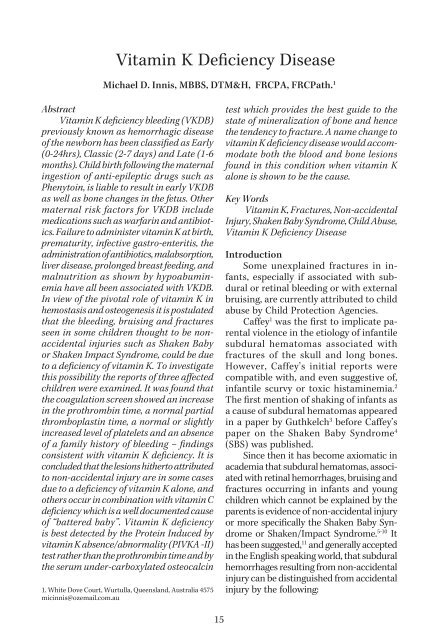

![Murder Inc. [polio/murder.pdf]](https://img.yumpu.com/36142565/1/163x260/murder-inc-polio-murderpdf.jpg?quality=85)
